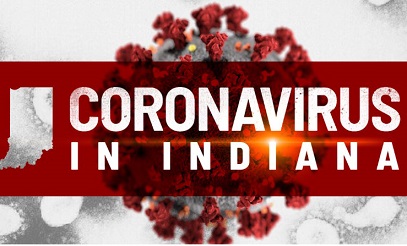Indiana State Reports 22 New COVID-19 Deaths And 846 Cases In 2 Weeks As FLiRT Variants Spreads Across America
Nikhil Prasad Fact checked by:Thailand Medical News Team May 10, 2024 11 months, 2 weeks, 3 days, 16 hours, 19 minutes ago
COVID-19 News: Indiana, like many other American states, continues to grapple with the impact of COVID-19. The Indiana Department of Health regularly updates its COVID-19 dashboard to provide transparent and current information to the public. According to the latest data collected through May 7, the state reported 22 new deaths in the last two weeks attributed to COVID-19. This brings Indiana's total COVID-19 death toll since March 2020 to 26,519, marking a slight increase from the previous reporting period.
 Indiana State Reports 22 New COVID-19 Deaths And 846 Cases
Indiana State Reports 22 New COVID-19 Deaths And 846 Cases
In 2 Weeks As FLiRT Variants Spreads Across America.
In addition to the new fatalities, Indiana recorded 846 new cases of COVID-19 within a two-week period. This uptick underscores the ongoing challenges posed by the virus, despite vaccination efforts and public health measures.
Death and Case Trends
Since January 2, Indiana has witnessed a total of 541 COVID-19-related deaths. Comparatively, the state reported 236 flu deaths for the 2023-2024 season by May 3, highlighting the significant impact of COVID-19 compared to seasonal influenza.
The number of probable COVID-19 deaths also saw a slight increase, rising by two since April 24. This brings the total of probable COVID-19 deaths in Indiana since March 2020 to 1,557.
https://www.coronavirus.in.gov/indiana-covid-19-dashboard-and-map/
https://www.coronavirus.in.gov/
Hospitalizations and Emergency Visits
The strain on Indiana's healthcare system is evident in the data regarding hospital admissions and emergency room visits. On Tuesday, Indiana recorded a seven-day average of seven hospital admissions, down from 19 reported on April 24. Similarly, emergency room visits increased slightly to 144, compared to 132 recorded on April 24.
These figures reflect the dynamic nature of COVID-19's impact on healthcare facilities, with fluctuations in hospitalizations and emergency visits influenced by various factors including infection rates, vaccination rates, and public health interventions.
Vaccination Efforts in Indiana
As of the latest data, approximately 54.8% of Indiana's population has completed the primary vaccination series, with 3,867,514 individuals having received the required doses. Additionally, 994,062 Hoosiers are up to date on vaccinations, while 996,277 have received the most recent booster.
While vaccination rates in Indiana show progress, ongoing efforts to promote vaccination and address vaccine hesitancy remain crucial in mitigating the spread of COVID-19 and its variants.
Emerging FLiRT Variants and Public Health Concerns
Amidst ongoing COVID-19 challenges, health authorities in the United States are closely monitoring the emergence of new SARS-CoV-2 variants, including the FLiRT variants o
f the SARS-CoV-2 virus. These variants, identified through surveillance efforts, present unique challenges and considerations for public health strategies.
The FLiRT variants, named after their distinctive mutations, have gained attention due to their prevalence and potential impact on disease transmission and severity. The two mutations found on these FLiRT variants i.e. F456L & R346T also probably makes these new lineages evasive to all kinds fo immunity i.e. either by previous infections or via the vaccines or both.
At present two of the KP sub-lineages which are FLiRT variants i.e. KP.2 and KP.1.1 are rapidly spreading the United States and becoming the predominant sub-lineages in circulation.
Characteristics and Symptoms of FLiRT Variants
Patients infected with FLiRT variants exhibit symptoms similar to those associated with earlier strains of COVID-19, including respiratory issues, fatigue, fever, cough, sore throat, and others. However, variations in symptoms and disease severity underscore the evolving nature of these variants and their impact on individuals.
Medical experts emphasize the importance of monitoring and understanding these variants' characteristics, including changes in the spike protein that facilitates viral entry into human cells.
Concerns and Implications
Health experts have expressed concerns regarding declining vaccination rates and their potential contribution to the spread of FLiRT variants and other strains of COVID-19. Vaccination remains a critical tool in combating the virus and reducing its impact on public health.
While current vaccines demonstrate effectiveness against FLiRT variants, ongoing research and surveillance are necessary to assess their long-term efficacy and inform vaccination strategies.
Smaller media companies across various counties and states across America are reporting
COVID-19 News coverages which indicate rising COVId-19 hospitalization and infection rates. Unfortunately, the Biden administration along the U.S. CDC and U.S. NIH are trying to conceal or downplay the COVID-19 surge starting in the United States and also the threat of the FLiRT variants by deploying various strategies including the latest in which hospitals across the United States need not report COVID-19 hospitalizations anymore to state or federal health authorities.
https://twitter.com/ThailandMedicaX/status/1785471310157758552
Public Health Measures
In response to the evolving landscape of COVID-19 variants, public health authorities continue to emphasize the importance of preventive measures. These include promoting vaccination, practicing mask-wearing in high-risk settings, maintaining physical distancing where applicable, and adhering to quarantine and isolation guidelines as needed.
Research and Surveillance
Continuous research, surveillance, and data analysis are essential components of effective pandemic response strategies. Monitoring variant trends, assessing vaccine efficacy, and identifying emerging challenges are fundamental to guiding public health interventions and protecting community health.
Collaboration and Communication
Collaboration between public health agencies, healthcare providers, community organizations, and individuals is key to navigating the complexities of COVID-19 and its variants. Transparent communication, timely updates, and coordinated efforts enhance resilience and response capabilities in addressing public health challenges.
Conclusion
The intersection of Indiana's COVID-19 data, the emergence of FLiRT variants, and ongoing public health efforts underscores the multifaceted nature of pandemic response. By leveraging data-driven insights, implementing targeted interventions, and fostering collaboration, communities can work towards mitigating the impact of COVID-19 variants and safeguarding public health. Continued vigilance, adaptability, and adherence to evidence-based practices are essential in navigating the evolving landscape of infectious diseases and promoting community well-being.
For the latest
COVID-19 News, keep on logging to Thailand Medical News.
